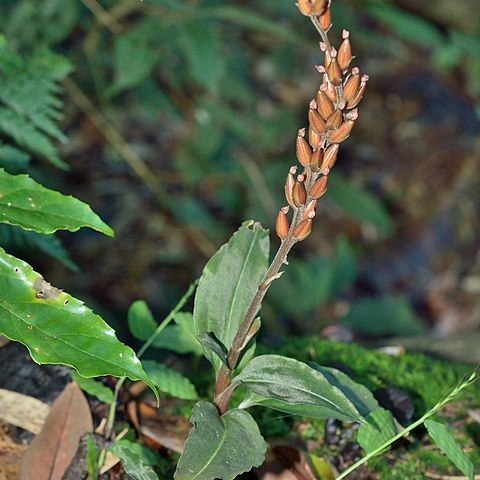Herbs, terrestrial or rarely epiphytic. Rhizome creeping, several noded, fleshy; roots fibrous, villous, arising from rhizome nodes. Stem erect, glabrous, with a few tubular sheaths at base, leafy. Leaves usually crowded at stem apex, green-red, midvein often white, lanceolate, ovate, or elliptic, oblique, apex acute, with a petiole-like base dilating into tubular amplexicaul sheath. Inflorescence erect, terminal, racemose, pubescent; peduncle with a few scattered sheathing bracts; rachis laxly to subdensely few to many flowered; floral bracts sparsely pubescent. Flowers not opening widely, obliquely resupinate or not resupinate; ovary and pedicel not twisted, glabrous to sparsely pubescent. Sepals free, similar, ovate-elliptic, outer surface glabrous to sparsely pubescent. Petals connivent with dorsal sepal and forming a hood, often broadly dilated, membranous; lip adnate to ventral margin of column, 2-partite or with a short mesochile and 3-partite; hypochile saccate, with a low, longitudinal carina along midvein forming a large, raised bicarinate callus toward apex of hypochile, and with 1 fleshy, undivided callus on either side near base; exterior of hypochile with fleshy flanges; mesochile (when present) short, margin involute; epichile linear, quadrate or transversely dilated, simple or 2-lobed. Column short, abruptly dilated apically, with 2 large, parallel wings; anther ovoid, 2-locular; pollinia 2, clavate, attached to a solitary, small, ovate viscidium; rostellum deltoid, short, broad, remnant shortly bifid; stigma lobes 2, separate, placed laterally at column apex, convex. Capsule erect.
More
Deciduous, shade-loving, terrestrial orchids with creeping, above-ground stems. Leaves petiolate, relatively narrow, thin-textured, dark green to brownish with a pale median band, arranged in a basal rosette. Inflorescence terminal on a stem, spicate. Flowers resupinate, relatively small, hairy or glabrous, dull-coloured, often short-lived. Dorsal sepal overlapping petals to form a loose galea. Lateral sepals free, spreading widely. Petals relatively broad, upper margin overlapped by dorsal sepal. Labellum obscurely lobed, basal hypochil sac-like, containing 2 fleshy, stalkless glands separated by a ridge; epichil separated by a sharp constriction, ending in a narrow, hooked lobe. Pollinia 4, deeply grooved, attached by shared caudicles to the viscidium.
These orchids grow in moist, sheltered sites in rainforest, often in flat areas where litter collects, and along stream banks; they also occur in accumulations of litter on boulders and in crevices.

